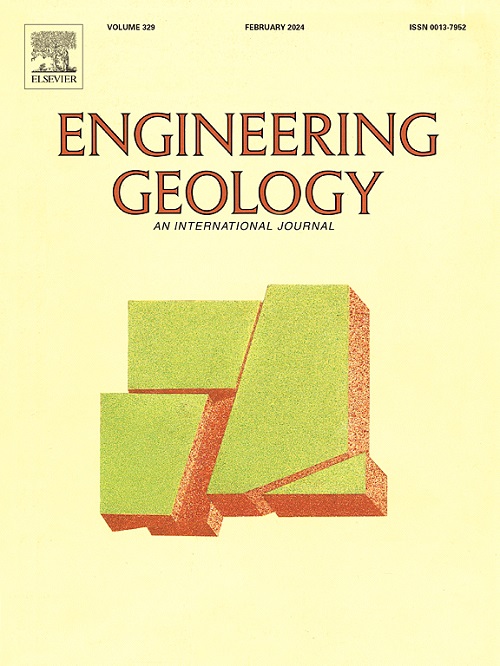Swelling creep diagenesis damage model for the Callovo-Oxfordian claystone
IF 6.9
1区 工程技术
Q1 ENGINEERING, GEOLOGICAL
引用次数: 0
Abstract
The French National Agency for Radioactive Waste Management (ANDRA) has been constructing an Underground Research Laboratory (URL) in Meuse/Haute-Marne since 2000 to determine the viability and protection of deep geological formation for hosting industrial nuclear waste repositories. The purpose of this URL is to describe the in situ properties and behavior of the Callovo-Oxfordian (COx) claystone. At the same time, various types of computational models have been developed to reproduce the in situ phenomena.
This paper presents an elastoviscoplastic model called SC2D: Swelling, Creep, Diagenesis, with anisotropic Damage, taking into account in situ measurements. This phenomenological model was developed to contribute to the understanding of the short- and long-term behavior of the COx claystone around the excavated drift. The model parameters are calibrated using in situ measurements and observations.
The model assumes that intact COx claystone (around from the excavated drift) exhibits elastic behavior with anisotropic damage in extension as macropores are occupied by calcite fibers. The short-term behavior of damaged COx claystone (near the excavated drift) is also characterized by an elastic mechanism with anisotropic damage. Sampling causes hydromechanical unloading that breaks the calcite fibers. Upon reloading the sample to site mean pressure, the damaged COx claystone first presents elastic behavior and then elastoplastic behavior depending on the load surface. Triaxial tests in axial compression and axial extension are conducted to validate this model with satisfactory results. Its long-term behavior follows an elastoviscoplastic mechanism.
Callovo-Oxfordian粘土岩的膨胀蠕变成岩损伤模型
法国国家放射性废物管理局(ANDRA)自 2000 年以来一直在默兹/上马恩省(Meuse/Haute-Marne)建造一个地下研究实验室(URL),以确定作为工业核废料储存库的深层地质构造的可行性和保护情况。该 URL 的目的是描述 Callovo-Oxfordian (COx) 粘土岩的原位特性和行为。与此同时,人们还开发了各种类型的计算模型来再现原位现象。本文结合原位测量结果,介绍了一种名为 SC2D:膨胀、蠕变、成因与各向异性损伤的弹塑性模型。这一现象学模型的开发有助于了解挖掘漂流物周围 COx 粘土岩的短期和长期行为。该模型假定完整的 COx 粘土岩(来自挖掘出的漂流物周围)表现出弹性行为,随着大孔隙被方解石纤维占据,在延伸过程中会出现各向异性损伤。受损的 COx 粘土岩(靠近挖掘出的漂流物)的短期行为也以各向异性损伤的弹性机制为特征。取样会导致水力机械卸载,使方解石纤维断裂。将样本重新加载到现场平均压力后,受损的 COx 粘土岩首先表现出弹性行为,然后根据加载面的不同表现出弹塑性行为。为验证这一模型,进行了轴向压缩和轴向延伸的三轴试验,结果令人满意。其长期行为遵循弹塑性机制。
本文章由计算机程序翻译,如有差异,请以英文原文为准。
求助全文
约1分钟内获得全文
求助全文
来源期刊

Engineering Geology
地学-地球科学综合
CiteScore
13.70
自引率
12.20%
发文量
327
审稿时长
5.6 months
期刊介绍:
Engineering Geology, an international interdisciplinary journal, serves as a bridge between earth sciences and engineering, focusing on geological and geotechnical engineering. It welcomes studies with relevance to engineering, environmental concerns, and safety, catering to engineering geologists with backgrounds in geology or civil/mining engineering. Topics include applied geomorphology, structural geology, geophysics, geochemistry, environmental geology, hydrogeology, land use planning, natural hazards, remote sensing, soil and rock mechanics, and applied geotechnical engineering. The journal provides a platform for research at the intersection of geology and engineering disciplines.
 求助内容:
求助内容: 应助结果提醒方式:
应助结果提醒方式:


